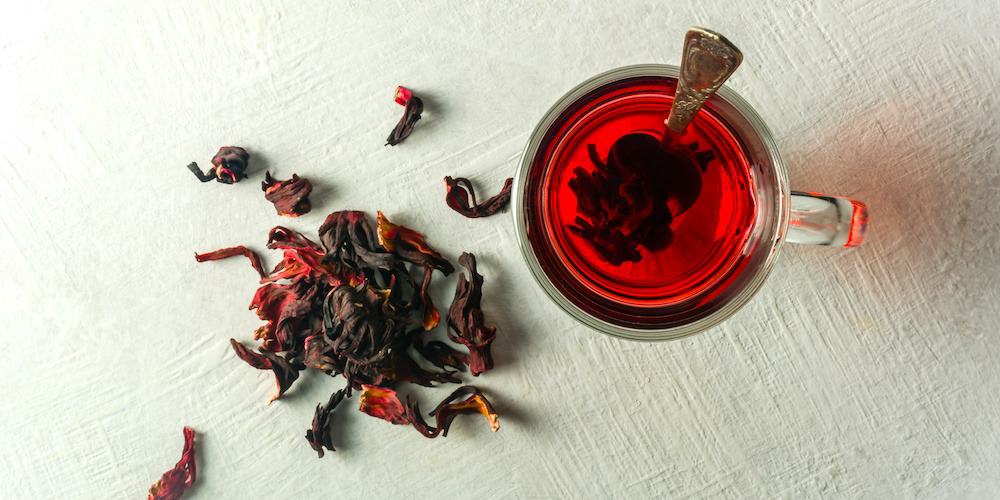BENEFITS OF BISSAP
✓ Reduces blood pressure
✓ Regulates cholesterol and triglyceride levels
✓ Aids weight loss
✓ Anti-inflammatory
✓ Fights free radical damage
What is bissap?
Bissap, a term from Senegalese Wolof, generally refers to bissap juice, hibiscus juice, or karkadé. These names describe the same beverage made from the flowers of Hibiscus sabdariffa. This hibiscus from the Malvaceae family primarily grows in Africa and Southeast Asia.
The Hibiscus sabdariffa can reach 1.80 m in height and offers abundant flowering from July to October. It produces beautiful red flowers that, once they fall, reveal the treasure of Hibiscus sabdariffa: its fruit or calyx.
The purple calyces of hibiscus have numerous traditional uses. Harvested from November to January, they are used in cooking as condiments, for making jams or sweet juices. Bissap is certainly the most famous juice obtained from hibiscus calyces.
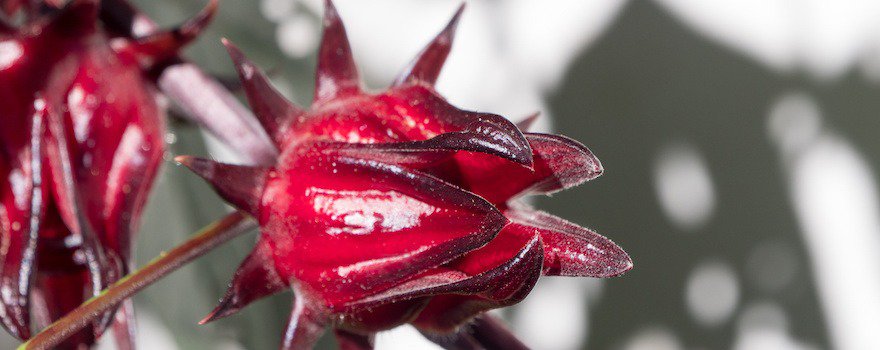
After harvesting, the calyces are husked, sun-dried, and then transformed into a beverage. They are soaked for several hours in water. Once filtered, the obtained drink is sweetened and optionally complemented with orange blossom water or pieces of fruit. At the end of the transformation, bissap takes on a tangy pink color.
Bissap is a highly appreciated drink in Africa, particularly in Senegal. The cultivation of Hibiscus sabdariffa and the production of bissap provide a significant source of income for Senegalese farmers.
Still little known in Europe, bissap is a refreshing drink with a tangy taste. But it’s not just its flavor that’s interesting! Bissap also has numerous health benefits due to its richness in antioxidants, vitamins, and minerals.
Nutritional Composition
- Vitamins: C, B2, B3
- Minerals and trace elements: calcium, iron
- Antioxidant pigments: anthocyanins (delphinidin 3-sambubioside, cyanidin 3-sambubioside)
- Polyphenols
- Proteins
- Lipids
- Sugars
- Pectin
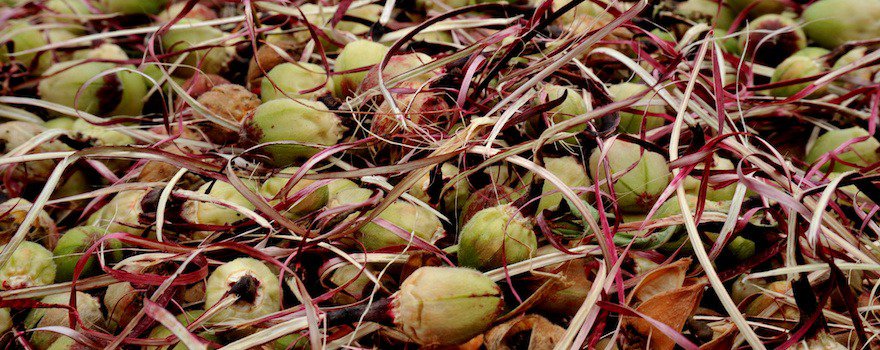
The Benefits of Bissap
❤️ Reduces Blood Pressure
Bissap is a very interesting health drink for reducing blood pressure. This hypotensive effect is due to the presence of anthocyanins, natural pigments that affect the process of vasodilation. By supporting the proper functioning of blood vessels and promoting blood circulation, bissap is a valuable ally for regulating blood pressure in the arteries.
Bissap also exhibits a diuretic effect—that is, it increases urine secretion. Consumption of diuretic foods is recommended to combat high blood pressure. By promoting the elimination of water and sodium from the body, they reduce the volume of blood circulating in the veins and thus blood pressure.
By fighting hypertension, bissap supports heart health and prevents cardiovascular diseases.
This study from Boston University, conducted on prehypertensive or mildly hypertensive adults, shows how hibiscus infusion can lower blood pressure.
🍳 Regulates Cholesterol and Triglyceride Levels
The exceptional composition of bissap gives it a cholesterol-lowering effect. Besides being antioxidants, anthocyanins also play a beneficial role in the levels of “bad cholesterol” or LDL-cholesterol. While reducing LDL-cholesterol levels, anthocyanins increase the level of “good cholesterol” or HDL-cholesterol.
Pectin and polyphenols present in bissap help improve fat metabolism and control the accumulation of triglycerides in the body. Finally, vitamin C and vitamin B3 (or niacin) also lower blood lipid levels.
This study from the University of Guadalajara, conducted on patients with metabolic syndrome, shows how powdered hibiscus flower extract reduced bad cholesterol and triglyceride levels.
🏃🏼 Helps with weight loss
Bissap has a slimming effect and supports weight loss. It prevents fat accumulation and decreases sucrose absorption. It also has the advantage of being low in calories and containing a large amount of water, which contributes to the body’s elimination and drainage.
Bissap is a purgative drink. Thanks to the pectin it contains, it promotes good intestinal function and improves digestion. These various actions make bissap a valuable ally for men and women who want to control their weight.
This study from the University of Iztapalapa in Mexico, conducted on obese mice, demonstrates the effectiveness of Hibiscus sabdariffa extract in reducing body weight.
🌵 Anti-inflammatory
Bissap is a natural anti-inflammatory. This action is partly due to the anthocyanins, which decrease inflammation markers. They particularly act on a key enzyme of inflammation: cyclooxygenase.
The polyphenols in bissap also exert an anti-inflammatory effect by interacting with the transcription factor NF-κB, an essential regulator involved in the body’s inflammatory response.
This study from the University of Medicine in Jakarta, conducted on rats, shows that Hibiscus sabdariffa extract is a potential anti-inflammatory.
🥝 Fights free radical damage
Due to its antioxidant content and vitamin C, bissap limits damage caused by free radicals. It protects the body’s cells and combats oxidative stress. As a result, it prevents the development of certain diseases promoted by free radicals.
The natural pigments in bissap also reduce oxidative damage and liver lesions. Some studies are also exploring the effects of Hibiscus sabdariffa on cancer cells.
In this study from the University of Milan-Bicocca, conducted on human tumor cells, Hibiscus sabdariffa extract inhibited their development.
How to consume bissap?
Bissap juice
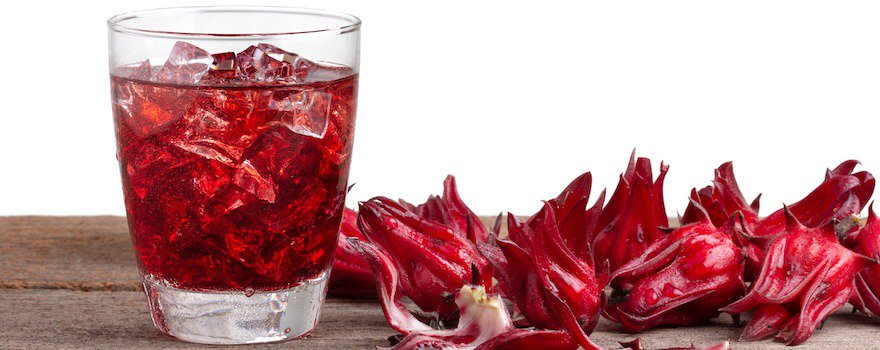
Bissap juice is the easiest form to find in organic and specialized stores or online. It is made from the flowers of Hibiscus sabdariffa left to infuse in water. The resulting juice is then sweetened and bottled. Depending on the recipes, bissap juice can also contain orange blossom, pineapple juice, nutmeg, or vanilla.
Note that you can make your own bissap drink. To do so, bring 1 liter of water to a boil, in which you will add 1 cup of dried Hibiscus sabdariffa flowers, 40g of sugar, 1/2 vanilla bean, a pinch of ground nutmeg, and a few drops of orange blossom.
Bissap juice is consumed fresh.
Bissap powder
Bissap can also be offered in powder form. It is made by finely grinding dried hibiscus flowers.
Bissap powder is used to prepare infusions, to be consumed hot or cold. You can also sprinkle it on your dishes to add a nice touch of color and a tangy flavor.
In cosmetics, bissap powder contributes to skin beauty. Applied to the face, hibiscus infusion has an anti-aging effect and brightens the complexion.
Dried hibiscus flowers
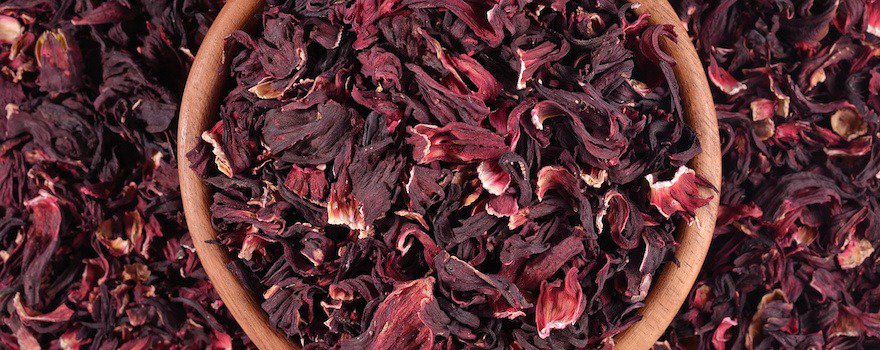
To make your own bissap or flavor your preparations, you can use dried hibiscus flowers offered in bulk.
Be sure to choose red hibiscus flowers and not white ones, which do not have the same properties. White flowers come from a different variety of hibiscus and have a more tart taste than red bissap.
Bissap, ginkgo biloba, and garcinia
To improve blood circulation, reduce hypertension, and boost antioxidants, combine bissap with ginkgo biloba.
To promote weight loss, you can also consume garcinia cambogia with slimming properties.
Bissap dosage
⚖️ It is recommended not to drink more than 3 cups per day of bissap juice.
⏳ Avoid consuming bissap late in the day, as its tonic action can cause insomnia. Bissap is a drink to be consumed daily or as a 4 to 6-week cure, before each change of season.
🥤As juice or infusion : up to 3 cups per day.
🥄 As powder : up to 30 g per liter of water.
🌺 As dried flowers : 5 tablespoons for 1 liter of water.
Contraindications and side effects
If the recommended dosage is followed, consuming bissap presents no toxicity. However, it is not recommended for the following people :
- As a precaution, and due to its emmenagogue effect, pregnant or breastfeeding women should avoid taking bissap.
- People suffering from liver disorders, hypertension, or heart diseases should consult their doctor before consuming it.
Consumption of bissap does not cause side effects. However, taken in very large quantities, bissap can be harmful to the liver.
History, culture, and market of bissap
An emblematic plant of West Africa
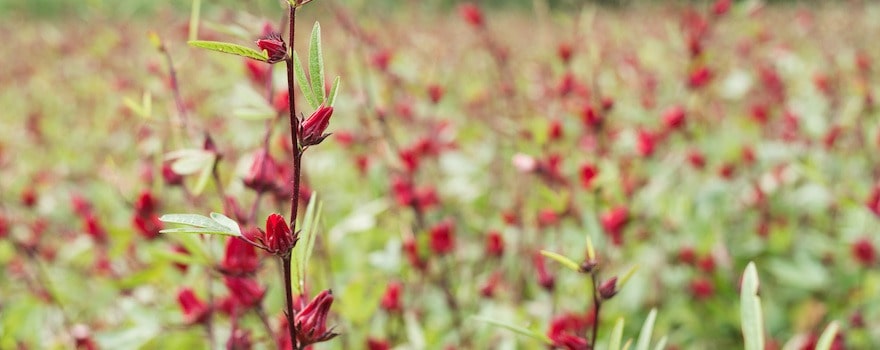
Developed from the 19th century, the cultivation of Hibiscus sabdariffa is now widespread in certain regions of Africa. Guinea, Burkina Faso, Mali, Benin, and Senegal are the main producers of bissap. Senegal alone accounts for between 30,000 and 40,000 cultivators of Hibiscus sabdariffa.
The calyxes are mainly used for making drinks, juices, powder, and jams. But they are not the only parts of the plant used. The leaves, for example, are consumed as vegetables in the manner of spinach. Their taste, resembling that of sorrel, has earned Hibiscus sabdariffa the nickname “Guinea sorrel”.
Dossier produced by Julia Perez and Charlotte Jean
Sources and scientific studies
McKay DL1, Chen CY, Saltzman E, Blumberg JB, 2010. Hibiscus sabdariffa L. tea (tisane) lowers blood pressure in prehypertensive and mildly hypertensive adults.
Gurrola-Díaz CM, García-López PM, Sánchez-Enríquez S, Troyo-Sanromán R, Andrade-González I, Gómez-Leyva JF, 2010. Effects of Hibiscus sabdariffa extract powder and preventive treatment (diet) on the lipid profiles of patients with metabolic syndrome (MeSy).
Alarcon-Aguilar FJ, Zamilpa A, Perez-Garcia MD, Almanza-Perez JC, Romero-Nuñez E, Campos-Sepulveda EA, Vazquez-Carrillo LI, Roman-Ramos R, 2007. Effect of Hibiscus sabdariffa on obesity in MSG mice.
Gulshan Fahmi El Bayani, Nurasi Lidya E. Marpaung, Dedy Arnold Sastrajaya Simorangkir, Imelda Rosalyn Sianipar, Nurhadi Ibrahim, Neng Tine Kartinah, Indra Gusti Mansur, Jan S. Purba, et Ermita I. Ibrahim Ilyas, 2018. Anti-inflammatory Effects of Hibiscus Sabdariffa Linn. on the IL-1β/IL-1ra Ratio in Plasma and Hippocampus of Overtrained Rats and Correlation with Spatial Memory.
Malacrida A, Maggioni D, Cassetti A, Nicolini G, Cavaletti G, Miloso M, 2016. Antitumoral Effect of Hibiscus sabdariffa on Human Squamous Cell Carcinoma and Multiple Myeloma Cells.


